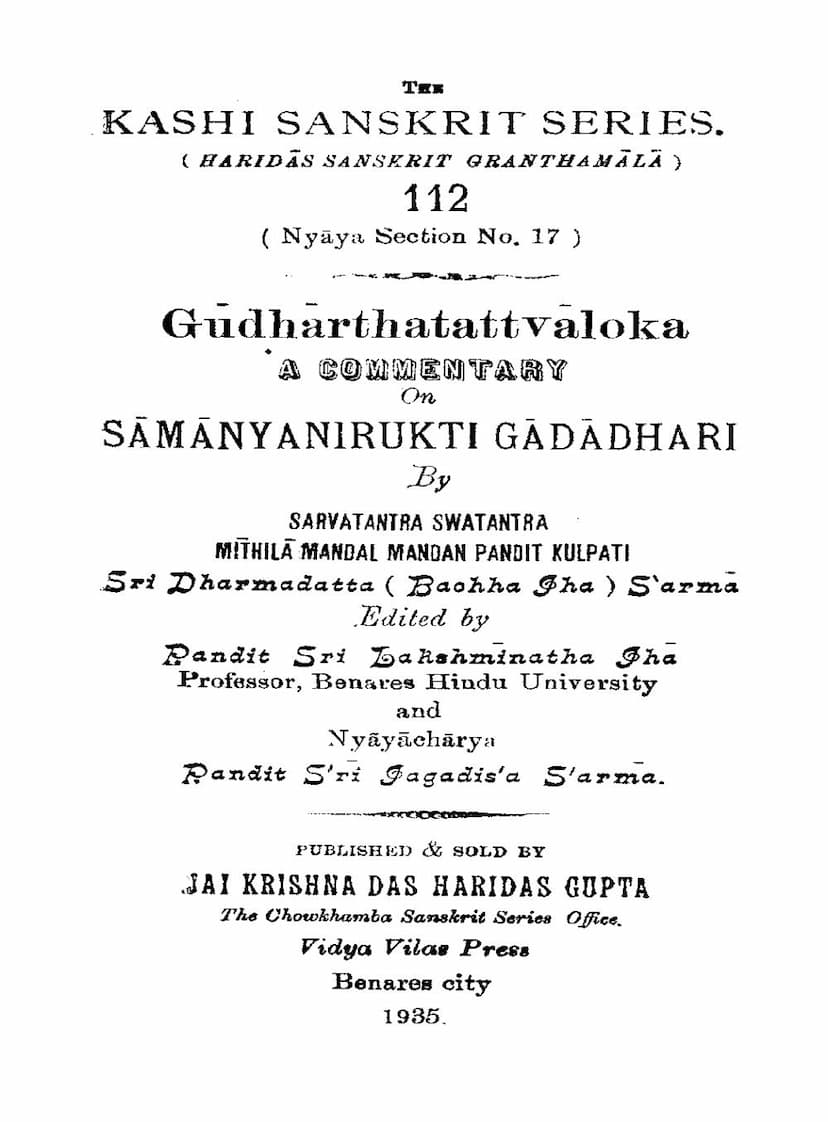Samanyanirukti Gudharthatattvaloka
Added to library: September 2, 2025

Summary
This is a comprehensive summary of the Jain text "Samanyanirukti Gudharthatattvaloka" by Dharmadattasuri, based on the provided pages:
Book Title: Samanyanirukti Gudharthatattvaloka (A Commentary on Samanyanirukti Gadadhari) Author: Pandit Sri Dharmadatta (also known as Bachha Jha) Publisher: Chaukhamba Vidyabhavan, Kashi Sanskrit Series (Haridas Sanskrit Granthamala) Year of Publication: 1935 (as indicated by the catalog link, though the text itself shows 1992 Vikram Samvat which corresponds to 1935 CE) Editors: Pandit Sri Lakshminatha Jha and Vyāyāchārya Pandit Sri Jagadis'a Jha (sons of the author)
Overall Summary:
"Samanyanirukti Gudharthatattvaloka" is a highly scholarly commentary by the renowned Jain philosopher Pandit Sri Dharmadatta Jha on the "Samanyanirukti" section of the "Gadadhari," a seminal work in the Navya Nyaya tradition, likely authored by Gadadhara Bhattacharya. The commentary is presented as an illumination of the profound and hidden meanings ("Gudhartha-Tattvaloka") within the complex philosophical discussions of the original text.
Key Themes and Content (based on the provided pages):
-
Introduction to Jain Philosophy and Moksha:
- The text begins with a devotional invocation and then delves into the fundamental Jain understanding of the human condition.
- It highlights that all beings naturally seek to escape suffering and attain happiness.
- The attainment of self-knowledge ("Atmabodham") is presented as the universally accepted path to this goal.
- The commentary emphasizes that self-knowledge is impossible without understanding the non-self ("Anatma").
- The purpose of analyzing "Anatma Pramana" (means of valid knowledge concerning the non-self) is rooted in the pursuit of liberation ("Moksha").
- The text quotes Vedic passages (e.g., "Ātmā vā are draṣṭavyaḥ...") to support the importance of understanding the Self for overcoming sorrow and achieving ultimate freedom.
- It distinguishes between the unenlightened (who seek only pleasure and fall into greater suffering) and the enlightened (who understand the impermanence of worldly pleasures and seek liberation from all suffering).
-
The Author and his Lineage:
- The preface extensively details the author's scholarly lineage and brilliance.
- Pandit Sri Dharmadatta Jha is described as a luminary in the Mithila region, highly accomplished in various branches of knowledge ("Sarvatantra Swatantra"), a poet, a logician, and an incarnation of wisdom, comparable to Shankaracharya in his spiritual insights.
- His father, Sri Durgadatta Jha, and grandfather, Sri Mahamahopadhyaya Ratnapani Jha Sharma, are also lauded for their vast knowledge and contributions to Dharma and philosophy.
- The text lists numerous works authored by Pandit Sri Dharmadatta Jha, covering diverse philosophical topics from Nyaya and Vedanta to commentaries on classical texts and literary works.
- The editors, Sri Lakshminatha Jha and Sri Jagadis'a Jha, are presented as devoted disciples and the author's own sons, ensuring the accurate preservation and dissemination of their father's profound scholarship.
- The author's commitment to teaching and upholding Vedic principles throughout his life is highlighted.
-
Detailed Analysis of Logical Concepts (Nyaya):
- The core of the commentary, starting from Page 9, engages in a highly technical and intricate discussion of various logical concepts, primarily related to the definition of "hetvābhāsa" (fallacious reasoning or pseudo-inference).
- The text meticulously dissects the definition of general fallacies, particularly focusing on the necessity and role of terms like "linga" (middle term), "jñāna" (knowledge), "vyāpti" (concomitance), and various types of fallacies like "vyāpyatvasiddhi" (non-concomitance).
- It engages in a rigorous debate with different philosophical schools and earlier commentators (like Mathuranatha and others), analyzing potential flaws in their definitions (e.g., over-extension "ativyāpti" and under-extension "avyāpti").
- The commentary delves into the nuances of "svarūpa-sambandha" (intrinsic relation), "avacchedakatva" (delimitation), "viṣayatva" (subject-matter), "viṣayitva" (predication), and "pratibandhakatva" (inhibitory relation).
- It examines the significance and potential redundancy of specific terms in logical definitions, demonstrating a deep understanding of logical structures and arguments.
- The text explores the conditions under which a logical proposition is considered valid or fallacious, engaging with concepts like "pramaṇa" (valid means of knowledge), "bhrama" (error), "saṃśaya" (doubt), and "apramāṇa" (invalid knowledge).
- The discussions often involve hypothetical scenarios and counter-arguments to refine the definitions and establish logical precision.
- The commentary demonstrates an analytical approach to identifying and resolving subtle distinctions and potential ambiguities in complex philosophical doctrines.
-
Scholarly Presentation:
- The text is written in highly Sanskritized Marathi or scholarly Hindi, reflecting the advanced philosophical discourse of the time.
- The "Shuddhipatra" (errata slip) at the end indicates the meticulousness of the editorial process and the scholarly standard aimed for.
- The detailed nature of the arguments suggests a profound engagement with the intricacies of Nyaya philosophy.
In essence, this work is a deep dive into the methodological and epistemological aspects of Jain philosophy as interpreted through the lens of classical Indian logic (Nyaya). Pandit Dharmadatta Jha, through his commentary, aims to clarify and illuminate the essential principles for attaining liberation, grounding these spiritual goals in rigorous intellectual analysis.